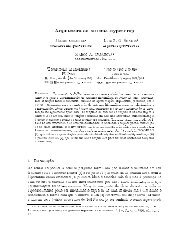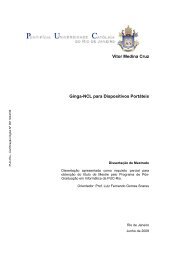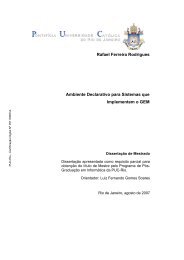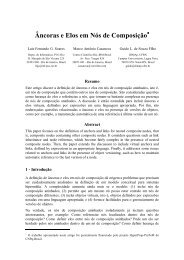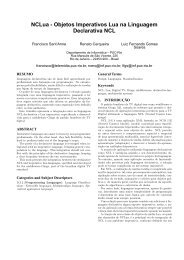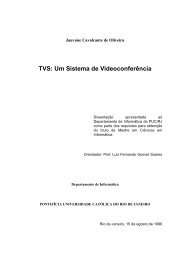Ginga-NCL: Declarative Middleware for Multimedia IPTV Services
Ginga-NCL: Declarative Middleware for Multimedia IPTV Services
Ginga-NCL: Declarative Middleware for Multimedia IPTV Services
You also want an ePaper? Increase the reach of your titles
YUMPU automatically turns print PDFs into web optimized ePapers that Google loves.
systems. The article is organized as follows. The<br />
next section overviews some related work. We<br />
then introduce the main <strong>NCL</strong> concepts. We present<br />
the <strong>Ginga</strong>-<strong>NCL</strong> architecture <strong>for</strong> <strong>IPTV</strong> systems.<br />
The last section is dedicated to our final<br />
remarks.<br />
RELATED WORK<br />
DTV applications can be partitioned into a set<br />
of declarative applications and a set of imperative<br />
applications [4]. A declarative application is<br />
an application whose initial entity is of a declarative<br />
content type. An imperative application is<br />
an application whose initial entity is of an imperative<br />
content type.<br />
Most terrestrial DTV systems offer support<br />
<strong>for</strong> both paradigms. For example, the European<br />
Digital Video Broadcast (DVB )[5] system and<br />
the American Advanced Television Systems<br />
Committee (ATSC) [6] system support Java,<br />
EcmaScript, and XHTML in their middleware<br />
specifications; the Association of Radio Industries<br />
and Businesses (ARIB) Japanese system<br />
also provides both declarative and imperative<br />
support, although current products implement<br />
only the declarative language BML [7], with<br />
EcmaScript as the scripting language. The Brazilian<br />
SBTVD system specifies Java and Lua as<br />
imperative languages <strong>for</strong> its middleware, called<br />
<strong>Ginga</strong>. <strong>NCL</strong> is the declarative language of <strong>Ginga</strong>.<br />
Besides offering an application programming<br />
interface (API) <strong>for</strong> interactive applications like<br />
terrestrial DTV, an <strong>IPTV</strong> middleware integrates<br />
specific <strong>IPTV</strong> components and services. Among<br />
those components, the most common are video<br />
on demand (VoD), linear TV, IP communication,<br />
remote software update, and content search<br />
engines.<br />
Most <strong>IPTV</strong> service providers use proprietary<br />
middleware implementations [8] from vendors<br />
like Microsoft, Minerva, Orca, Siemens, Soft-<br />
AtHome, and Alcatel-Lucent. Microsoft Mediaroom<br />
(an evolution of Microsoft TV) [9] is based<br />
on the .NET framework compact <strong>for</strong> end terminals,<br />
in order to offer a C#/XML API (Silverlight)<br />
<strong>for</strong> applications. Minerva Networks has<br />
developed a middleware known as iTVManager<br />
[10], which offers a C language interface <strong>for</strong> its<br />
applications. The RIGHTV middleware [11],<br />
developed by Orca Interactive, is based on<br />
XHTML browsers. Siemens has acquired Myrio<br />
[12], which offers Java and XHTML APIs. The<br />
SoftAtHome operating plat<strong>for</strong>m [13] is a recent<br />
initiative from Orange, Thomson, and Sagem to<br />
provide a declarative application environment<br />
based on HTML, JavaScript, and Adobe Flash.<br />
Alcatel-Lucent’s MiViewTV [14] offers a development<br />
framework totally based on Adobe<br />
Flash.<br />
Lightweight Interactive <strong>Multimedia</strong> Environment<br />
(LIME) [15], like <strong>NCL</strong>, is an ITU-T Recommendation<br />
<strong>for</strong> <strong>IPTV</strong> multimedia applications<br />
and is based on the Japanese BML standard <strong>for</strong><br />
broadcasting. LIME specifies a small profile of<br />
XHTML, CSS, DOM, and EcmaScript, where<br />
broadcast-specific functions from BML were<br />
removed. The LIME EcmaScript API contains<br />
extensions to deal with <strong>IPTV</strong>-specific functionalities<br />
such as <strong>IPTV</strong> EPG, persistency, content<br />
licensing, media presentation control, and<br />
TCP/IP communications. LIME supports not<br />
only user interaction events, but also broadcaster<br />
events, by means of bevent and beitem elements.<br />
A beitem element describes an event message<br />
and the corresponding action (usually a function<br />
written in EcmaScript) to be accomplished when<br />
the event occurs. Note that although spatiotemporal<br />
synchronization among media objects can<br />
be controlled by broadcast systems, the behavior<br />
must be imperatively defined using scripts.<br />
After the advent of broadband TV, broadcast<br />
content may share its audience with downloaded<br />
widgets and online tasks like browsing and messaging.<br />
This has pushed broadcasters and service<br />
operators to define standardized plat<strong>for</strong>ms that<br />
harmonize and explore this hybrid scenario.<br />
HbbTV [16] supports web technologies like<br />
XHTML and EcmaScript <strong>for</strong> broadcast or downloaded<br />
applications. However, application signaling<br />
is done in the broadcast domain. The HbbTV<br />
standardization process started in the third quarter<br />
of 2009 in the European Telecommunications<br />
Standards Institute (ETSI).<br />
The BBC’s Project Canvas [17] is an initiative<br />
to standardize a common plat<strong>for</strong>m that broadcasters<br />
can join, making their multimedia content<br />
available to compatible <strong>IPTV</strong> terminals.<br />
Some discussions and consultations are still running<br />
at BBC Trust, and there are no technical<br />
standards published yet, although web technologies<br />
are said to be a natural choice.<br />
Verizon’s FiOS TV [18] offers a framework<br />
<strong>for</strong> developing TV widgets based on the Lua language.<br />
The framework incorporates the Lua virtual<br />
machine and extended Lua APIs such as<br />
Graphics, Events, Timers, and Webservices.<br />
Authoring DTV applications using imperative<br />
languages is more complex and more errorprone<br />
than using declarative domain-specific<br />
languages (DSLs). Moreover, imperative interpreted<br />
system languages like Java have engines<br />
that are very resource consuming and have a<br />
considerable memory footprint. On the other<br />
hand, XHTML carries a legacy from previous<br />
technologies developed <strong>for</strong> text navigation and<br />
<strong>for</strong>matting, and lots of add-ons have been created<br />
to overcome its limitations. XHTML is<br />
focused on user interactions <strong>for</strong> media asset presentation<br />
synchronization, <strong>for</strong>cing application<br />
authors to solve spatiotemporal synchronization<br />
that goes further than simple user interactions,<br />
as well as content and presentation adaptations<br />
and other issues, using imperative objects, usually<br />
implemented using EcmaScript. Thus, the<br />
great advantage of using declarative DSL is lost,<br />
with the expense of using a scripting language<br />
greedy in CPU and memory consumption.<br />
A declarative approach that fulfills the main<br />
requirements of a DTV application, relegating<br />
to the imperative approach only particular computations,<br />
seems to be the right solution <strong>for</strong> a<br />
DTV middleware API. This approach would<br />
boost integration, simplicity and better resource<br />
usage in <strong>IPTV</strong> plat<strong>for</strong>ms. Besides that, it would<br />
make the authoring process easier and less errorprone.<br />
<strong>NCL</strong> [1] and MPEG-4 Lightweight Application<br />
Scene Representation (LASeR) [19] are the<br />
technologies currently closest to fulfilling these<br />
A declarative<br />
application is an<br />
application whose<br />
initial entity is of a<br />
declarative content<br />
type. An imperative<br />
application is an<br />
application whose<br />
initial entity is of<br />
an imperative<br />
content type.<br />
IEEE Communications Magazine • June 2010 75



